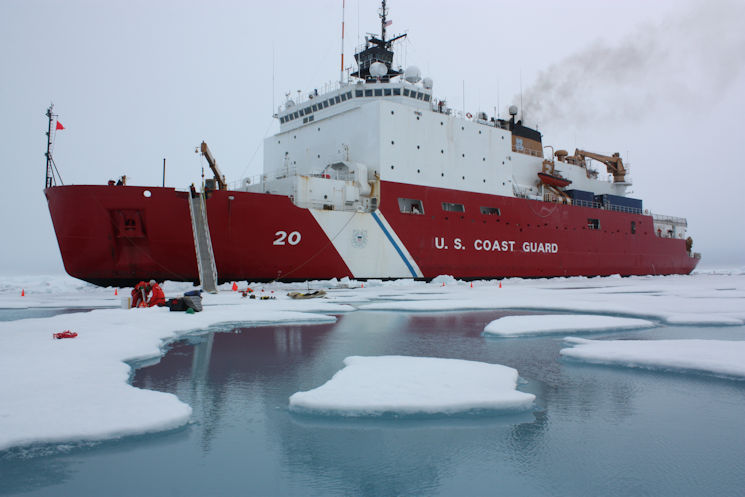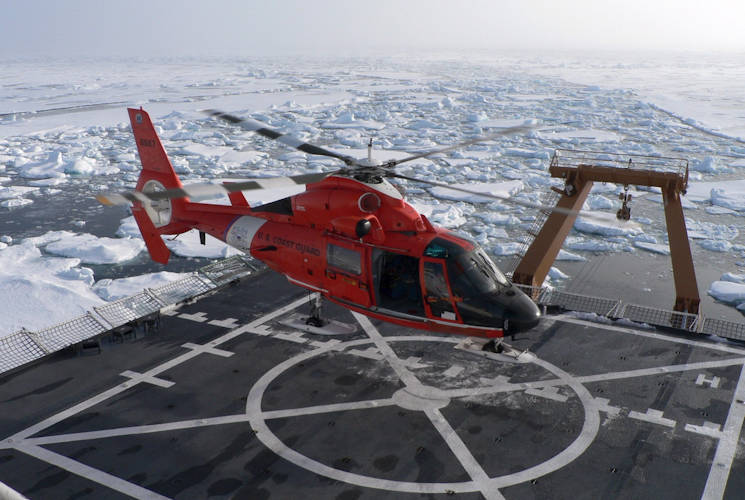|
Life aboard Coast Guard Cutter Healy is unique and different from
any other job I have had during my Coast Guard career. The Healy's
mission is mainly science based, although we do maintain a readiness
posture in the event we are needed for an emergency or search and
rescue operations.
|

On July 6, 2011, the U.S. Coast Guard Cutter Healy parked in an ice floe for the 2011 ICESCAPE mission's third ice station in the Chukchi Sea.
The ICESCAPE mission, or "Impacts of Climate on Ecosystems and Chemistry of the Arctic Pacific Environment," is NASA's two-year shipborne investigation to study how changing conditions in the Arctic affect the ocean's chemistry and ecosystems. The bulk of the research takes place in the Beaufort and Chukchi seas in summer 2010 and 2011.
(NASA photo by Kathryn Hansen)
Note...
At 420 feet long and 82 feet wide, the Coast Guard Cutter Healy is the Coast Guard's largest cutter. Onboard you'll find an impressive galley, large medical facility, science lounge, ship's store, a library, and crews' lounges, which all prove handy for a group who will be underway continuously for 65 days. Morale events are on-going for both the Coast Guard crew and science party, including trivia nights, movie marathons, and talent shows. Physical fitness classes and an oceanography course are also available to the crew.
|
I act as one of the safety supervisors for deck evolutions. I
oversee the safety of personnel and the deployment of any type of
science gear or apparatus. Everything we do on deck is inherently
dangerous. We lift many types of large, heavy, and/or awkward
equipment ranging from devices that can collect mud and seafloor
samples, water at different depths or even collect sea creatures
unique to this region. We use large cranes and A-frames hoists to
lift and then lower the science gear over the side of the boat into
the water, often times letting it drop all the way to the ocean
floor. We train long and hard to mitigate any possible danger in
order to provide the safest working environment possible.
As one of the deck watch officers, I have been lucky enough to
drive the Healy, which is especially exciting and unique. When
navigating through the ice, there are a lot of factors involved in
choosing the best path to take. We need to see where there might be
open water, thinner ice, and we need to avoid ridges where there is
extremely dense ice formation. We transfer control from the bridge
to the aloft conning station above the bridge, in order to get a
better look at everything. There is definitely a specific skill set
and learning curve for driving a ship through thick ice, but it is
such an exciting thing to learn and do. I always look forward to
having the opportunity to drive in the ice because not only can you
see forever from aloft conning station, but watching a ‘lead', or
crack form in the ice as we break through, is truly exhilarating. I
can truly say that I love my job.
|

September 26, 2015 - Coast Guard Cutter Healy crewmembers deploy a small boat to enable scientists to collect water samples. Healy is underway in the Arctic Ocean in support of the National Science Foundation-funded Arctic GEOTRACES, part of an international effort to study the distribution of trace elements in the world's oceans.
(U.S. Coast Guard photo by Petty Officer 2nd Class Cory J.
Mendenhall)
|
It's also been incredible to drive our small boats around in the
arctic. We lower our smaller boats down from the ship via a Miranda
davit or sled, which is an exciting experience in and of itself, for
a variety of reasons. But driving a small 26 foot boat around amid
the crystal clear water and blue and white ice floes never gets old
or routine. As we make our way through the water, the boat crew
members are always ready to push smaller ice floes out of the way
with boat poles if needed and we assist the scientists with anything
they might need. I get the chance to get up close and personal with
the Arctic environment, and I feel extremely lucky to be able to do
something that not a lot of people can say they have done.
The Healy has been my home for almost 4 years now. I will never get
tired of coming to the Arctic and taking in the stark beauty of the
ice, and all of the amazing wildlife. Seeing a polar bear and her
cubs out in the wild is truly unforgettable!
Being away from family is the hardest part of deployment by far.
Being this far north on the planet comes with technological
disadvantages and we live for those moments when we can get a phone
call through or when we receive an email from home – especially if
it includes pictures.
|

August 24, 2005 – A U.S. Coast Guard HH-65 Dolphin helicopter prepares to depart the Coast Guard cutter USCGC Healy (WAGB 20) to fly members of a science party to a remote ice floe to collect ice samples and data about Arctic sea ice.
(U.S. Navy photo by Aerographer's Mate 1st Class Gene Swope)
|
I have loved having space in the hangar to hold CrossFit workouts
and classes. I was lucky enough to be given the chance to create a
CrossFit “box” for the ship, and we have daily workouts for those
who are interested. It's been a great way to break up the
deployment, interact “outside of work” and have something to focus
on.
One of the things I love the most about my job is being
able to tell people about my experience at the North Pole. How many
people can say that they have been to the North Pole?! Having been
there is really still surreal and indescribable. As you might
expect, the weather is pretty brutal. The wind, coupled with the
arctic temperatures, made it tough to be outside taking in that once
in a lifetime experience for very long, but I relished every second
of it! Being part of the crew in 2015, as the first U.S. surface
vessel to make it to the North Pole unaccompanied, was truly an
honor, and something I will never forget.
|

September 9, 2013 - Hanu Singh, a scientist with the Woods Hole Oceanographic Institute, explains the process required to put the institute's unmanned underwater vehicle into the water to Petty Officer 3rd Class Brian Gangl,
a boatswain's mate aboard the Coast Guard Cutter Healy, during a
simulated oil spill recovery exercise walk-through on the icebreaker
in the Arctic Ocea. The Healy deck department worked with science
and research passengers to safely maneuver many pieces of heavy,
sensitive equipment into the water. (U.S. Coast Guard photo by Petty
Officer 3rd Class Grant DeVuyst)
|
But, I must admit that the very best part about being
stationed on the Healy is the camaraderie that is unique to
a polar icebreaker. We live and work together for months at
a time out in the frozen wasteland of the Arctic, and it
gives you the chance to become really close with your
shipmates as your shared experiences bond you together.
Once you have experienced a trip to the Arctic, you are
forever a member of a rather remarkable and exclusive club.
There is just something about crossing that 66 degree latitude and
entering the “Arctic Realm” that is truly extraordinary.
By U.S. Coast Guard Petty Officer 1st Class Kenny Cook
Provided
through
Coast
Guard
Copyright 2016
Comment on this article |



